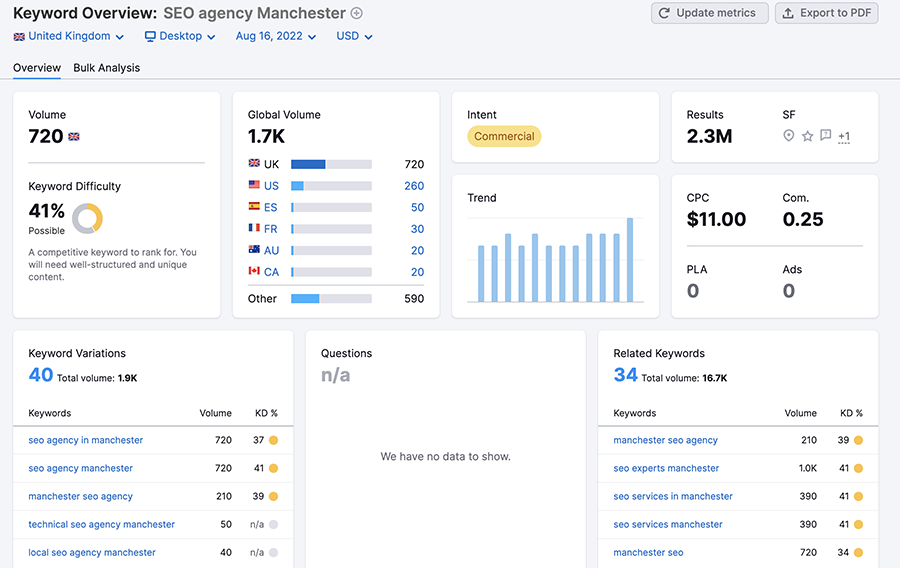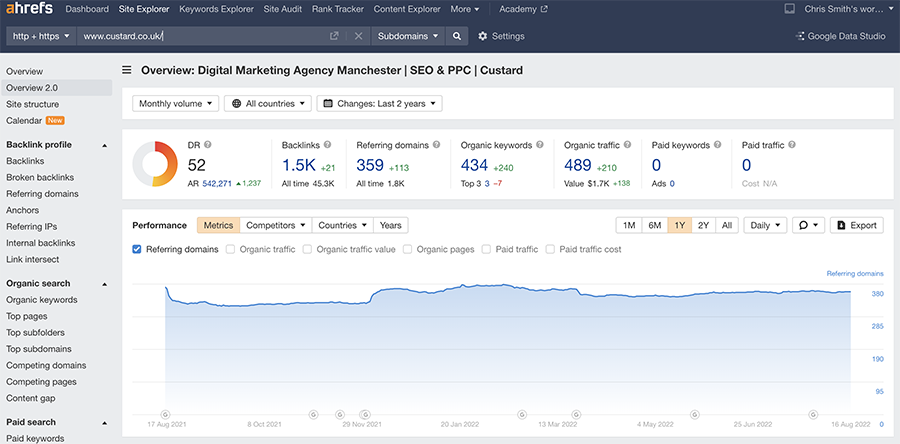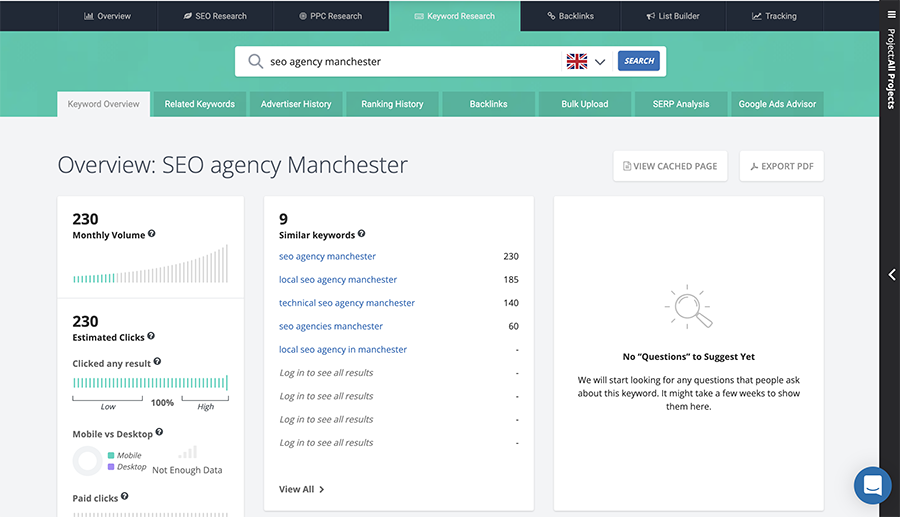
Is your website as visible as you’d like it to be? Are you curious about what your top competitors are doing that you’re not? If so, then an SEO competitor analysis may be in order. In this blog post, we’ll introduce you to the principle of SEO competitor analysis and show you how to get started with your SEO competitor research. We’ll also give you tips on how to stay ahead of the competition. So, whether you’re just starting out or are looking for ways to improve your current SEO strategy, read on to find out how to do a competitor analysis!
What is SEO competitor research?
SEO competitor research is the analytical process of examining your competitors and their marketing strategies to determine their strengths and weaknesses. It can help you understand what tactics your competitors are using to bring in traffic and how you can improve your own website to compete. Performing a SEO competitor analysis is an important step in any effective SEO strategy.
Your SEO competitor analysis checklist should include:
- Keyword analysis
- Backlink analysis
- Keyword gap analysis
- Content analysis
Most marketers utilise an SEO competitor analysis tool to expedite the process and gather large data sets easily. These tools can also be used to create SEO competitor analysis reports. Ahrefs, Semrush, and Moz are just some examples of SEO competitor analysis tools.
Ultimately, by studying your competitors’ successes and failures in attracting and engaging online users, you can create an effective strategy that improves your website, sets you apart from the crowd and helps you achieve your business goals while avoiding any of your competitor’s pitfalls.
Why is a SEO competitor analysis important for your business?
An SEO competitor analysis is important for your business because it can help you understand how your competitors are ranking in search engine results pages (SERPs), what keywords they are targeting, and what strategies they are using to drive traffic to their websites. This information can help you optimise your own website SEO for better search engine visibility and traffic.
Need more reasons for why you need to conduct your own competitor analysis, take a look at the benefits of conducting an SEO competitor analysis. Firstly, it can help you identify your strongest and weakest competitors. This information can be used to develop targeted strategies that will give you an edge over your rivals. Additionally, competitor analysis can help you uncover new opportunities for growth; for example, if one of your competitors is ranking well for a keyword that you’re not targeting, you may want to consider adding it to your own SEO strategy.
How to conduct a SEO competitor analysis for your website
Now we’ve covered what SEO competitor analysis is, it’s time to look at how to conduct the analysis. There are many different ways to understand your competition. Below, we’ve covered just some of the most common processes, which you can start using right away.
Identify your competitors
Identify the competition is the first step in doing an SEO competitor analysis. Whilst it may sound counter-intuitive, not all websites that rank higher than yours for your target keywords are your competitors, we recommend discovering who your genuine competitors are when it comes to your competitor analysis keywords.
How to identify your competitors
Start by making a list of who you consider your competitors. If you’re working with a client, ask their marketing team or stakeholders to contribute. Try to focus on websites that rank highly or often for your main target keywords and any significant additional keywords.
If you’re working on a new website, you may not know who your competitors are. You can try building your list by using Google search to see which websites are ranking for similar products/services or using tools like SEMRush to identify these.
In order to discover your genuine SEO competition in your SEO analysis, you must be thorough and exact. This entails comparing and researching SEO for a variety of keywords and noting the top 10 or 20 websites that appear consistently for all of them.
Filter out who isn’t your competition
With this initial list of 10 – 20 sites, you may want to remove those which cover a wide range of products/services outside of your niche (such as Amazon) or manufacturers who rank for their own brand terms, as outranking these sites may not be possible. It’s not always worth it to try to outrank Wikipedia or Pinterest for a certain keyword when focusing your time on other less competitive terms can drive better results.
Competitor keyword analysis
With your list of relevant competitors, you will want to look at the keywords each of them are ranking for by performing competitor keyword analysis. This entails identifying which keywords and phrases your competitors are targeting, and then devising a strategy to target those same keywords and phrases.
Performing competitor keyword analysis can be done manually, however using software can speed up the process dramatically. With your list of competitors, you can begin by entering each website into a tool like Semrush, Ahrefs or Moz. These tools will provide you with data on each site’s organic and paid search traffic, as well as the keywords they are targeting. This information can help you to identify which keywords your competitors are targeting, the average monthly search volumes and ranking position.
Once you have that information, you can begin incorporating those same keywords and phrases into your own website and marketing materials. You may also want to consider bidding on these keywords as part of a paid search campaign in Google Ads, to drive traffic to your site whilst working on SEO improvements.
Backlink analysis
Backlinks are one of the most important aspects of SEO. They are links from other websites that point to your website. When other websites link to your website, it tells Google that your website is an authority on a certain topic. This can help your website rank higher in the search engines.
When doing a backlink analysis, the quantity of backlinks pointing to your website is definitely important, but the quality of those backlinks is even more vital. In order to determine the quality of a backlink, you need to look at a few factors, such as the authority of the website that is linking to you, the relevance of the content on that website, and how old the link is.
There are a few different ways to do a backlink analysis. The first is to use a tool like Ahrefs and Moz. You can enter in your website’s URL and it will show you all of the websites that are linking back to you. It will also show you the anchor text used for those links, which can give you some good ideas for optimising your own website’s SEO.
Another way to do a backlink analysis is to use Google Search Console. This tool will show you all of the websites that have linked to you, as well as how many clicks each link has received.
Finally, another way to do a backlink analysis is by using Majestic SEO. This tool shows you how many links your website has, as well as how strong those links are. It also shows you how your website’s ranking has changed over time.
If you have a lot of low-quality backlinks, then you may want to consider disavowing those links. This will tell Google that you no longer want those links pointing to your website.
Content analysis
A content analysis is a process of evaluating your website’s content to see how well it ranks for certain keywords. You can use this information to improve your website’s ranking and visibility. This involves looking at all content on your site including title tags, meta descriptions, heading tags, images, and other elements to make sure they are all properly optimised for search engines. This process of reviewing content looks for factors that can enhance or limit its organic performance.
In most cases this process will have two main sections:
- Evaluating the pre-existing content on your site for potential problems
- Analysing content ideas to find the top-ranking elements for their target keywords
SEO competitor analysis tools
As a business, it is important to understand how you compare to the competition in order to stay competitive. SEO competitor analysis tools are essential for staying on top of the game and keeping an eye on your competition. These tools allow businesses to examine their competitors’ search engine optimisation efforts and discover areas in which they can improve their own strategies.
The best SEO competitor analysis tool will provide a detailed overview of all aspects related to your competitors’ SEO performance. With this information, you can better understand why your competitors are ranking higher than you in search engine results pages (SERPs) and how you can adjust your strategy accordingly. These tools should also provide insights into link building strategies, content relevancy and keyword usage so that you can gain further insight into the success of competing websites.
SEMRush
SEMRush is the leading SEO software, with a database of 131 nations. It is used by many small and mid-sized businesses. Its dashboard component is ideal for SEO competitor analysis, since it shows the percentage of branded to non-branded traffic, the number of search queries, and the quantity of traffic branded search generates, as well as how it has trended over time. Knowing this will help you in determining the competitor analysis keywords your competitors are utilising to rank well in Google, as well as whether or not those phrases are related to your niche.

Ahrefs
Ahrefs is well-known for its high-quality backlink data and for being one of the top link tools available.
This tool, however, is also useful for your competitor analysis because Ahrefs has a set of reports that offer you a list of competitors based on the quantity of related keywords. When it comes to data precision, Ahrefs won’t be able to detect your competitors precisely because it doesn’t take into account factors like domain size or industry.
You can use the Content Gap analysis if you suspect that your keyword approach is incorrect. This analysis will show you which keywords your competitors are using but your domain isn’t. This provides you with an opportunity to take advantage of the situation and boost your ranks. Using this information can assist you in moving forward with your SEO strategy.

SpyFu
SpyFu is an SEO competitive landscape data provider that has been around for a while. SpyFu can also provide you a list of competitor names for the domain you’re looking at if you’re trying to identify who your most aggressive competitors are.
Another excellent feature is the SEO Overview dashboard. It provides a detailed analysis of a domain’s performance, including the distribution of its position on the first page of search results and other information.

SERPstat
Serpstat is relatively new to the market and appears to duplicate capabilities seen in other SEO software products; the data quality is comparable to that of Semrush and SpyFu.
The main dashboard provides a quick overview of the most popular pages, which is really beneficial. It will save you time and prevent you from having to go through the tedious process of exporting organic rankings data and creating pivot tables in Excel.
SimilarWeb
SimilarWeb can help you figure out how a website generates visitors. This tool provides the percentage of search traffic that comes from various search engines as well as traffic distribution across all channels (search, social, direct, etc.).
You have the option of searching at the keywords that bring the most traffic from search engine results. You can tell which keywords should be your top priority based on this information because they have the potential to drive more traffic to your website. SimilarWeb also provides a list of competitors based on the kind of websites that are ranking for the same set of keywords in search engines.
What is the best SEO competitor analysis tool?
Finding the best SEO competitor analysis tool for your business can be a daunting task. With so many tools on the market, you may find yourself overwhelmed with options and unable to decide which one is best suited for your organization’s needs.
The reality is that there isn’t a single “be all and end all” tool when it comes to SEO competitor analysis. While some tools may have more features than others, ultimately success in this area boils down to trial and error – finding out what works for your business model, website structure, and industry competition.
If you’re unsure of where to start, consider reaching out to an experienced marketing agency like us who can provide professional advice on which tool(s) would be most beneficial for your digital presence. We can analyse the landscape of competitors in your industry and recommend suitable solutions tailored specifically for you.
Conclusion
In conclusion, doing a SEO competitor analysis is an important way to understand your competition, their strategies, and how to improve your own website’s ranking. By following the steps in this article, you can create a comprehensive report that will help you stay ahead of the competition. If you need help with your SEO, be sure to get in contact with our team at Custard. We can provide you with all the help you need to increase your website’s ranking and visibility. Contact us today or follow the link to find out how we can help your on page SEO!





